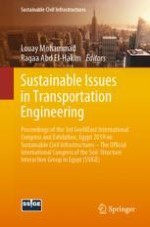2020 | Buch
Sustainable Issues in Transportation Engineering
Proceedings of the 3rd GeoMEast International Congress and Exhibition, Egypt 2019 on Sustainable Civil Infrastructures – The Official International Congress of the Soil-Structure Interaction Group in Egypt (SSIGE)
herausgegeben von: Prof. Dr. Louay Mohammad, Dr. Ragaa Abd El-Hakim
Verlag: Springer International Publishing
Buchreihe : Sustainable Civil Infrastructures
